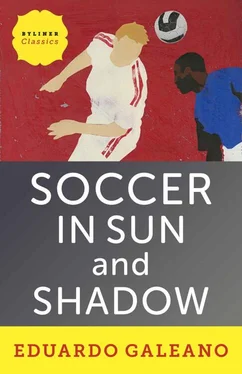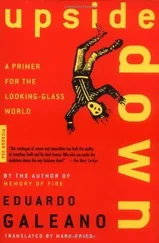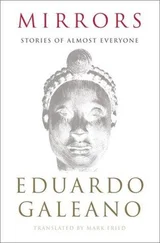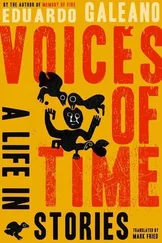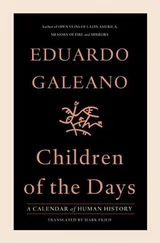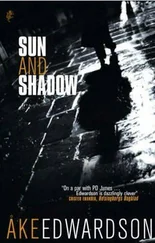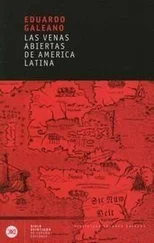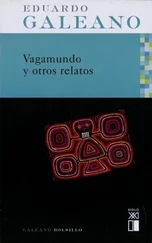Ever since television started showing players up close, the entire uniform, from head to toe, has turned into a billboard. When a star takes his time tying his shoes, it’s not slow fingers but pocketbook smarts: he is showing off the Adidas, Nike, or Reebok logo. Even back in the ’36 Olympics organized by Hitler, the winning athletes featured Adidas’s three stripes on their shoes. In the 1990 World Cup final between Germany and Argentina, Adidas’s stripes were everywhere, including the ball and every strip of clothing worn by the players, the referee, and the linesmen. Two English journalists, Simson and Jennings, reported that only the referee’s whistle didn’t belong to Adidas.
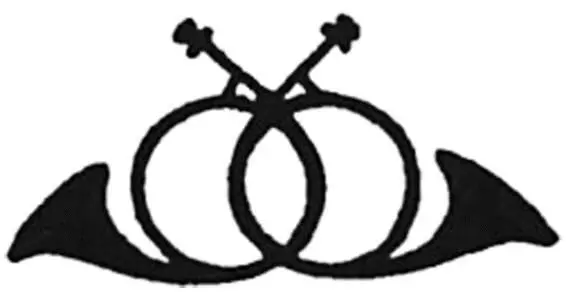
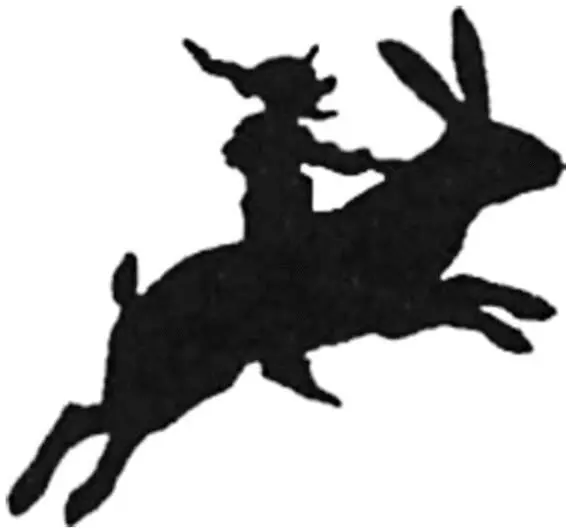
It was 1957. Spain was playing Belgium.
Miguel caught the Belgian defense sleeping, penetrated on the right and volleyed a cross kick to center. Di Stéfano leaped forward, diving full-length, and scored with a backheel from the air.
Alfredo Di Stéfano, the Argentine star who became a Spaniard, had a habit of scoring goals like that. Any open net was an unforgivable crime meriting immediate punishment, and he carried out the sentence by stabbing at it like a mischievous elf.
The entire playing field fit inside his shoes. From his feet it sprouted and grew. Alfredo Di Stéfano ran and re-ran the field from net to net. When he had the ball he would switch flanks and alter the pace, from a lazy trot to an unstoppable cyclone; when he didn’t, he would evade his marker to gain open space, seeking air to keep a play from getting choked off.
He never stood still. Holding his head high, he could see the entire playing field and cross it at a gallop to pry open the defense and launch the attack. He was there at the beginning, the during, and the end of every scoring play, and he scored goals of all colors:
Watch out, watch out,
here comes the arrow
faster than all get out.
The crowd would carry him off the field on their shoulders.
Di Stéfano was the engine behind three teams that amazed the world in the 1940s: River Plate, where he took Pedernera’s place; Millonarios from Bogotá, where he sparkled alongside Pedernera; and Real Madrid, where he was Spain’s leading scorer five years in a row. In 1991, years after he retired, the magazine France Football bestowed on this Buenos Aires boy the title of “best European player of all time.”
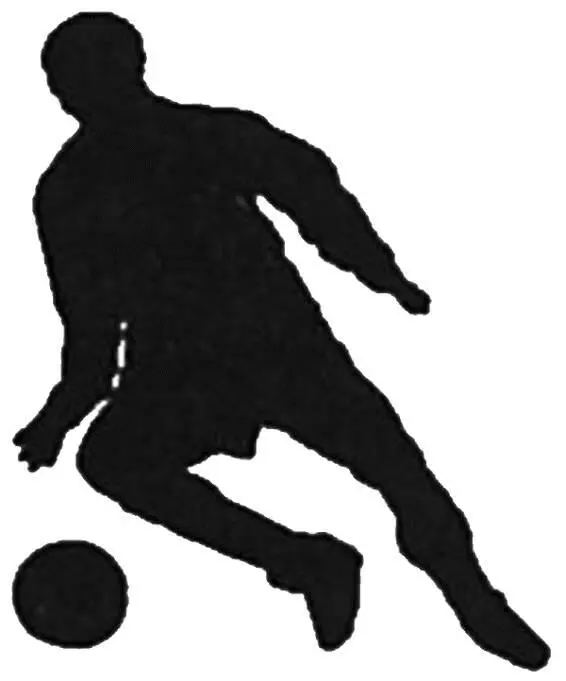
It was in Italy in 1958. Brazil’s national team was playing Club Fiorentina on the way to the World Cup in Sweden.
Garrincha invaded the penalty area, left one defender sitting on his bottom, shook off another, and then one more. He eluded the goalkeeper too, then discovered another defender on the goal line. Garrincha made like he was going to shoot, then like he wasn’t; he faked a kick at the near corner and the poor fellow crashed face first into the post. By then the goalkeeper was back. Garrincha put the ball between the keeper’s legs and flew into the net along with it.
Afterward, with the ball under his arm, he slowly returned to the field. He walked with his gaze lowered, Chaplin in slow motion, as if asking forgiveness for the goal that had all Florence on its feet.
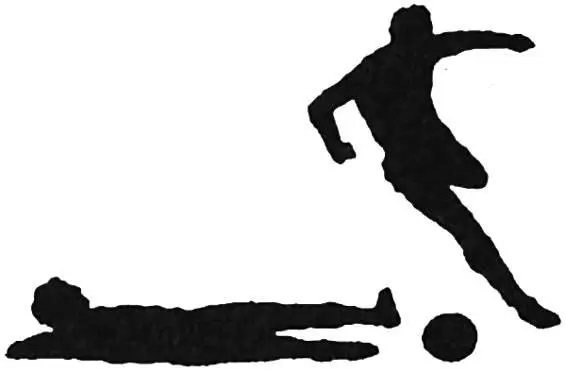
The United States was launching a satellite into the high heavens, a new little moon to circle the earth. It crossed paths with Soviet Sputniks but never said hello. And while the great powers were competing in the Great Beyond, in the Here and Now civil war was breaking out in Lebanon, Algeria was burning, France was catching fire, and General de Gaulle was standing six feet tall above the flames and promising salvation. In Cuba Fidel Castro’s general strike against the Batista dictatorship was failing, but in Venezuela another general strike was dooming the dictatorship of Pérez Jiménez. In Colombia, Conservatives and Liberals were at the polls to bless their deal to divvy up power after a decade of mutual extermination, while Richard Nixon was being welcomed with stones on his Latin American tour. Deep Rivers by José María Arguedas was being published, as were Carlos Fuentes’s Where the Air Is Clear and Idea Vilariño’s Poemas de amor .
In Hungary, Imre Nagy was being shot along with other rebels from ’56 who wanted democracy instead of bureaucracy, and dying too were the Haitian rebels who had launched an assault on the palace where Papa Doc Duvalier reigned amid sorcerers and executioners. John XXIII, John the Good, was the new Pope in Rome; Prince Charles was the future monarch of England; Barbie was the new queen of dolls. In Brazil João Havelange was conquering the throne in the industry of soccer, while in the art of soccer a seventeen-year-old kid named Pelé was being hailed king of the world.
The consecration of Pelé took place in Sweden during the sixth World Cup. Participating were twelve teams from Europe, four from the Americas, and none from other latitudes. Swedes could watch at the stadium or in their homes. This was the first Cup to be televised, although it was broadcast live only in Sweden. The rest of the world saw it later.
This was also the first time that a country playing outside its own continent won. At the beginning of the 1958 World Cup the Brazilians were nothing special, but after the players rebelled and convinced the coach to field the team they wanted, they were unstoppable. At that point five substitutes became starters, among them an unknown teenager named Pelé and Garrincha, who was already famous in Brazil and had sparkled in the qualifying matches, but had been left off the starting line because psychological testing showed him to have a weak mind. These black second-stringers to white starters blazed with their own light in the new star team, along with another astonishing black, Didi, who organized their magic from the back.
Games and flames: the London paper World Sports said you had to rub your eyes to believe that it was of this world. In the semifinal against the French team of Kopa and Fontaine, the Brazilians won 5–2, and they won again 5–2 in the final against the home team. The Swedish captain, Liedholm, one of the cleanest and most elegant players in the history of soccer, converted the first goal of the match, but then Vavá, Pelé, and Zagalo put the Swedes in their place under the astonished gaze of King Gustavus Adolphus. Brazil became champion without suffering a single defeat. When it was over, the victorious players gave the ball to their most devoted fan, the black masseur Américo.
France took third place and West Germany fourth. Fontaine of France led the list of scorers with a shower of thirteen goals, eight with the right leg, four with the left, and one with his head, followed by Pelé and Helmut Rahn of Germany, who scored six apiece.
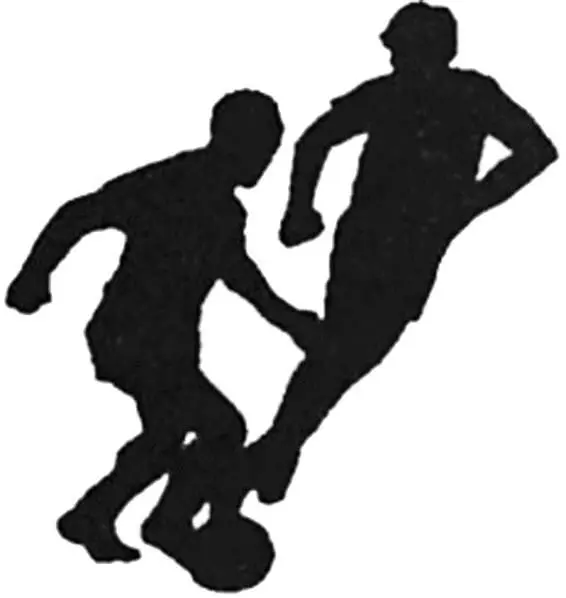
Читать дальше
